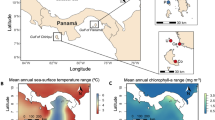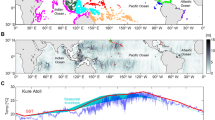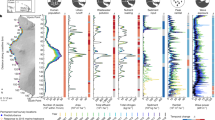Abstract
Climate-change impacts on coral reefs are expected to include temperature-induced spatially extensive bleaching events1. Bleaching causes mortality when temperature stress persists but exposure to bleaching conditions is not expected to be spatially uniform at the regional or global scale2. Here we show the first maps of global projections of bleaching conditions based on ensembles of IPCC AR5 (ref. 3) models forced with the new Representative Concentration Pathways4 (RCPs). For the three RCPs with larger CO2 emissions (RCP 4.5, 6.0 and 8.5) the onset of annual bleaching conditions is associated with ∼ 510 ppm CO2 equivalent; the median year of all locations is 2040 for the fossil-fuel aggressive RCP 8.5. Spatial patterns in the onset of annual bleaching conditions are similar for each of the RCPs. For RCP 8.5, 26% of reef cells are projected to experience annual bleaching conditions more than 5 years later than the median. Some of these temporary refugia include the western Indian Ocean, Thailand, the southern Great Barrier Reef and central French Polynesia. A reduction in the growth of greenhouse-gas emissions corresponding to the difference between RCP 8.5 and 6.0 delays annual bleaching in ∼ 23% of reef cells more than two decades, which might conceivably increase the potential for these reefs to cope with these changes.
This is a preview of subscription content, access via your institution
Access options
Subscribe to this journal
Receive 12 print issues and online access
$209.00 per year
only $17.42 per issue
Buy this article
- Purchase on SpringerLink
- Instant access to full article PDF
Prices may be subject to local taxes which are calculated during checkout




Similar content being viewed by others
References
Hoegh-Guldberg, O. et al. Coral reefs under rapid climate change and ocean acidification. Science 318, 1737–1742 (2007).
Pandolfi, J. M., Connolly, S. R., Marshall, D. J. & Cohen, A. L. Projecting coral reef futures under global warming and ocean acidification. Science 333, 418–422 (2011).
Taylor, K. E., Stouffer, R. J. & Meehl, G. A. An overview of CMIP5 and the experiment design. Bull. Am. Meteorol. Soc. 93, 485–498 (2012).
Moss, R. H. et al. The next generation of scenarios for climate change research and assessment. Nature 463, 747–756 (2010).
Turner, B. L. et al. A framework for vulnerability analysis in sustainability science. Proc. Natl Acad. Sci. USA 100, 8074–8079 (2003).
Lim, B., Spanger-Siegfried, E., Burton, I., Malone, E. & Huq, S. Adaptation Policy Frameworks for Climate Change: Developing Strategies, Policies and Measures (United Nations Development Programme, 2005).
Climate Change and the Great Barrier Reef (Great Barrier Reef Marine Park Authority and the Australian Greenhouse Office, Department of the Environment and Water Resources, 2007).
Osborne, K., Dolman, A. M., Burgess, S. C. & Johns, K. A. Disturbance and the dynamics of coral cover on the great barrier reef (1995–2009). PLoS ONE 6, e17516 (2011).
Coles, S. L. & Brown, B. in Advances in Marine Biology Vol. 46, 183–223 (2003).
Mcclanahan, T. R., Ateweberhan, M., Muhando, C. A., Maina, J. & Mohammed, S. M. Effects of climate and seawater temperature variation on coral bleaching and mortality. Ecol. Monogr. 77, 503–525 (2007).
Donner, S., Skirving, W., Little, C., Oppenheimer, M. & Hoegh-Guldberg, O. Global assessment of coral bleaching and required rates of adaptation under climate change. Glob. Change Biol. 11, 2251–2265 (2005).
Teneva, L. et al. Predicting coral bleaching hotspots: The role of regional variability in thermal stress and potential adaptation rates. Coral Reefs 31, 1–12 (2012).
Brown, B. Coral bleaching: Causes and consequences. Coral Reefs 16, 129–138 (1997).
Wilkinson, C. Status of Coral Reefs of the World: 1998 (Australian Institute of Marine Science, 1999).
Hoegh-Guldberg, O. Climate change, coral bleaching and the future of the world’s coral reefs. Mar. Freshw. Res. 50, 839–866 (1999).
Donner, S. Coping with commitment: Projected thermal stress on coral reefs under different future scenarios. PLoS ONE 4, e5712 (2009).
Sheppard, C. Predicted recurrences of mass coral mortality in the Indian Ocean. Nature 425, 294–297 (2003).
Hoeke, R. K., Jokiel, P. L., Buddemeier, R. W. & Brainard, R. E. Projected changes to growth and mortality of Hawaiian corals over the next 100 years. PLoS ONE 6, e18038 (2011).
Van Hooidonk, R. & Huber, M. Effects of modeled tropical sea surface temperature variability on coral reef bleaching predictions. Coral Reefs 31, 121–131 (2011).
Andrews, T., Gregory, J. M., Webb, M. J. & Taylor, K. E. Forcing, feedbacks and climate sensitivity in CMIP5 coupled atmosphere–ocean climate models. Geophys. Res. Lett. 39, L09712 (2012).
Reifen, C. & Toumi, R. Climate projections: Past performance no guarantee of future skill? Geophys. Res. Lett. 36, L13704 (2009).
Collins, M. et al. The impact of global warming on the tropical Pacific Ocean and El Niño. Nature Geosci. 3, 391–397 (2010).
Hoegh-Guldberg, O. & Bruno, J. F. The impact of climate change on the World’s marine ecosystems. Science 328, 1523–1528 (2010).
Meinshausen, M. et al. The RCP greenhouse gas concentrations and their extensions from 1765 to 2300. Climatic Change 109, 213–241 (2011).
Van Vuuren, D. P. et al. The representative concentration pathways: An overview. Climatic Change 109, 5–31 (2011).
Huth, R. Sensitivity of local daily temperature change estimates to the selection of downscaling models and predictors. J. Clim. 17, 640–652 (2004).
Reynolds, R., Rayner, N., Smith, T., Stokes, D. & Wang, W. An improved in situ and satellite SST analysis for climate. J. Clim. 15, 1609–1625 (2002).
Gleeson, M. W. & Strong, A. Applying MCSST to coral-reef bleaching. Adv. Space Res. 16, 151–154 (1995).
Van Hooidonk, R. & Huber, M. Quantifying the quality of coral bleaching predictions. Coral Reefs 28, 579–587 (2009).
Acknowledgements
The community archives housing the data used here are described in the Methods. This study was partly financially supported by EPHE/CNRS and CRIOBE and IRCP (French Polynesia) through grants originally awarded to S.P., and partly financially supported by a grant to all authors from the Pacific Islands Climate Change Cooperative. This research was performed while R.v.H. held a National Research Council Research Associateship Award at NOAA AOML. P. Marshall and K. Anthony provided helpful comments. We thank M. Huber, Purdue ITAP and RCAC for their resources and assistance.
Author information
Authors and Affiliations
Contributions
R.v.H. and J.A.M. designed the study. Climate data were collated and analysed by R.v.H. All authors contributed to writing the manuscript.
Corresponding author
Ethics declarations
Competing interests
The authors declare no competing financial interests.
Supplementary information
Supplementary Information
Supplementary Information (PDF 5079 kb)
Rights and permissions
About this article
Cite this article
van Hooidonk, R., Maynard, J. & Planes, S. Temporary refugia for coral reefs in a warming world. Nature Clim Change 3, 508–511 (2013). https://doi.org/10.1038/nclimate1829
Received:
Accepted:
Published:
Issue Date:
DOI: https://doi.org/10.1038/nclimate1829



